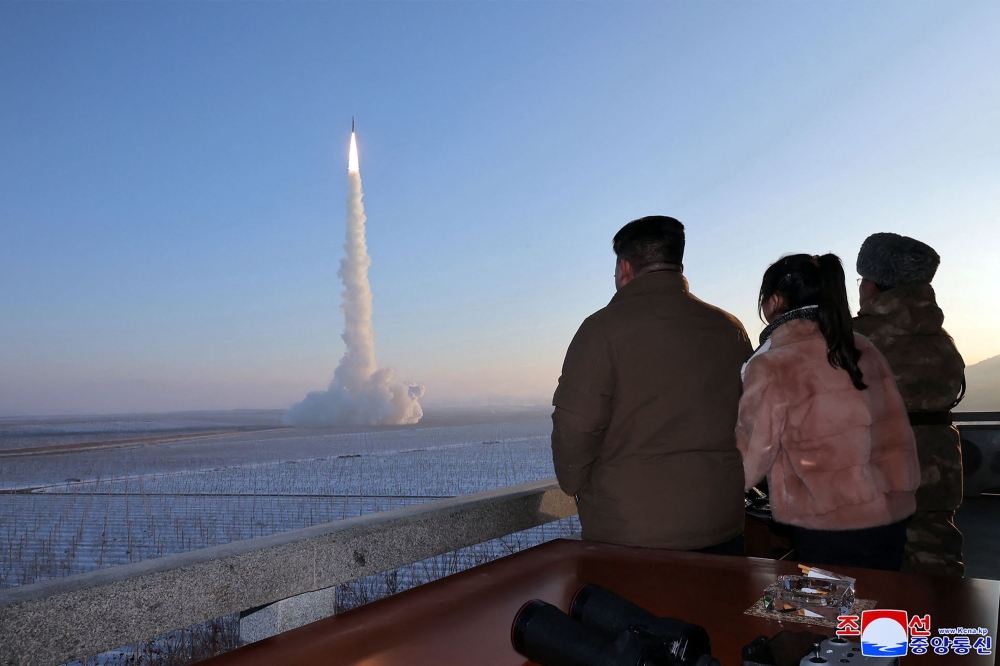SEOUL, Oct 31 — North Korea said today it had test-fired one of its newest and most powerful weapons to boost its nuclear deterrent, with Seoul warning it could be a solid-fuel intercontinental ballistic missile.
AFP takes a look at what we know:
What is a solid-fuel missile?
Solid-fuel missiles are powered by a chemical mixture which is cast into the missile’s airframe when it is built—like a firecracker rocket, ready to go.
In contrast, liquid-fuelled missiles typically require that the fuel and an oxidiser be inserted before they can be fired—a slower and more cumbersome process.
For leader Kim Jong-un’s purposes, this creates “a time period for South Korea to detect and target preemptively before the launch,” said Han Kwon-hee of the Korea Association of Defence Industry Studies.
This is the whole premise of South Korea’s so-called “Kill Chain” defence system, Han said.
That is why Kim wants solid fuel missiles.
“It allows for rapid launches with minimal preparation,” Han said, adding that they can be deployed “almost instantly”.
A man watches a television screen showing a news broadcast with file footage of a North Korean missile test, at a train station in Seoul on October 31, 2024. North Korea on October 31 fired a ‘long-range ballistic missile’, South Korea’s military said, Pyongyang’s first weapons test since Seoul accused it of sending tens of thousands of soldiers to Russia. — AFP pic
Why is Kim testing it now?
Analysts have speculated North Korea timed the intercontinental ballistic missile (ICBM) test as a response to accusations by the United States and South Korea that it is sending thousands of soldiers to Russia to help fight Ukraine.
Seoul had warned that a North Korean missile launch or even a nuclear test was imminent ahead of next week’s US election.
The ICBM launch is part of North Korea’s effort to “reframe its troop deployment to Russia as a legitimate response to the threat posed by the United States,” Hong Min, a senior analyst at the Korea Institute for National Unification, told AFP.
Seoul says that in addition to dispatching troops to Russia, Pyongyang has sent 13,000 shipping containers full of artillery shells, anti-tank rockets and missiles.
So what’s the message?
North Korea claims the launch today was a “very crucial” test of an ICBM.
Such missiles have a minimum range of 5,500 kilometres and are primarily designed to deliver nuclear warheads — which allows Kim to threaten the US.
The launch “demonstrates that Russia and North Korea, as nuclear-armed states, possess the capability to operate strategic nuclear weapons against the United States,” Hong said.
Kim may be signalling to Washington that “the North Korea-Russia alliance is, in essence, a nuclear alliance.”

This undated picture released by North Korea’s official Korean Central News Agency (KCNA) on December 19, 2023 shows North Korean leader Kim Jong-un and his daughter watching the test launch of a Hwasongpho-18 intercontinental ballistic missile (ICBM) at an undisclosed location in North Korea. — AFP pic
Do Kim’s ICBMs work?
North Korea claimed to have successfully tested its first ICBM in 2017 — the Hwasong-14, a missile capable of reaching Alaska — and has rolled out bigger and more powerful weapons since.
North Korea fired what has become known as the “monster missile” in November 2022, and tested a solid-fuel ICBM last year.
The record-breaking ICBM launch today “reached an altitude of 7,000km and flew for 1 hour and 26 minutes,” South Korean lawmaker Yu Yong-weon, who sits on the defence committee in parliament, wrote on Facebook.
“This makes today’s launch the longest ever by North Korea, and possibly by any country,” Seoul-based specialist site NK News reported.
The duration and altitude indicate the North “tried to evaluate whether a heavy multiple-warhead ICBM can indeed reach the US mainland,” Yang Moo-jin, president of the University of North Korean Studies in Seoul, told AFP.
All of North Korea’s ICBMs — including today’s launch — have been test-fired on a lofted trajectory — meaning up not out.
Experts question whether they could survive reentry into the atmosphere and prove accurate over greater ranges.
What else has Kim got?
His arsenal is substantial: cruise missiles, intermediate-range ballistic missiles, hypersonic missiles, and even a submarine-launched ballistic missile — although experts say Pyongyang’s exact sea-based launch capabilities remain unclear.
North Korea has also conducted six previous nuclear tests, with South Korea’s military telling lawmakers this week that the North could again attempt “to highlight nuclear issues before the US presidential election.”
Kim toured a uranium enrichment facility in September — with state media releasing images of it for the first time — and Seoul has said “preparations at the Punggye-ri nuclear test site in Kilju County are nearly complete,” for a seventh test.
By flexing its military muscles, Kim is sending a clear message to Washington, experts said.
By successfully test-firing a solid-fuel mission “it could enable surprise ICBM attacks on US territories without prior warning,” Kim Ki-ho, a North Korean studies expert who teaches at Seoul Christian University, told AFP.
“This effort is aimed at enhancing their negotiating power, regardless of who wins the upcoming US presidential election.” — AFP








